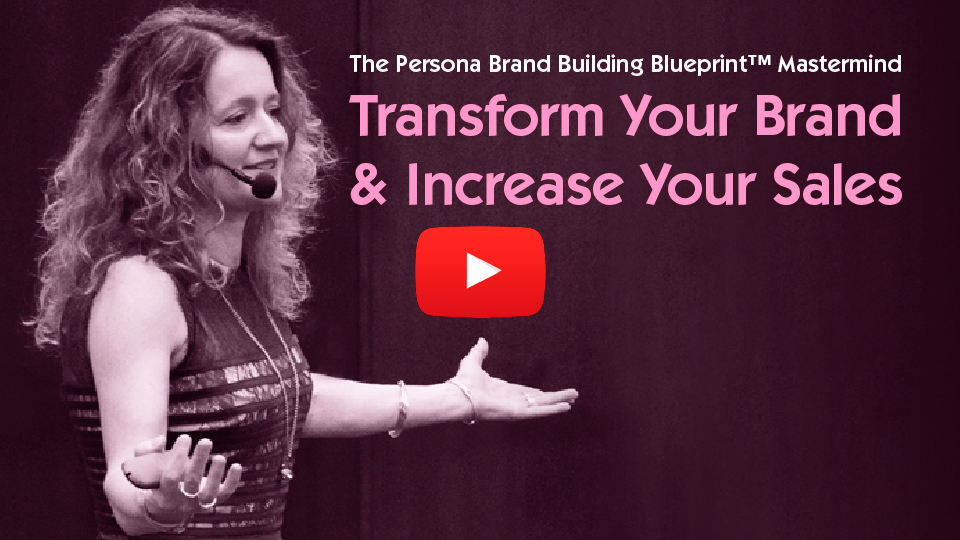Profitable Lessons from Luxury Brand Leaders, Brand Positioning for Premium Pricing
/0 Comments/in Luxury Brand, Luxury Branding /by Lorraine Carter7 Powerful Components Of A Lasting Luxury Brand
/0 Comments/in Luxury Brand, Luxury Branding /by Lorraine CarterThe landscape for luxury brands is changing in a dramatic way. According to the latest edition of the annual Bain Luxury Study, the personal luxury goods market experienced nearly flat growth (defined as growth of less than 3%) for the third year in a row as of the end of 2016.[1] It’s a sharp contrast with the rapid expansion the luxury brand market has seen in the previous two decades.
And the market itself isn’t the only thing changing; the luxury consumer and the sheer definition of what it means to be a luxury brand have shifted as well. According to the 2017 State of the Luxury Industry Study, which surveyed some of the foremost influencers in the luxury space, “ideas that have [previously] defined luxury – aspiration, status, exclusivity, wealth – have taken on negative connotations. The new luxury is not a showoff.”[2]
This new and modern landscape means that now more than ever, brand strategy is paramount for purveyors of luxury goods and services. Here are seven brand values a modern luxury brand should focus on to stay relevant (not to mention well-loved) in an ever-more-competitive marketplace.
7 Luxury Brand Factors Needed to Stay Relevant and Thrive
1. Luxury Brand Innovation
The definition of luxury is no longer entirely up to the luxury brand. As technology and access to technology improves more and more with each passing year, the definition of luxury lies in the hands of the customer. Consumers have spoken, and they crave innovation.
In the State of the Luxury Industry survey cited above, luxury influencers were asked about the most important business priorities for luxury brands in the year ahead. More than 600 of those surveyed cited innovation as a critical strategic priority.
And it’s not simply about going high-tech either. It’s up to luxury brands to innovate with;
- Novel products
- New services
- Forward-thinking marketing strategies and
- Contemporary ways to engage with affluent customers
When it comes to product, blending form and function is a key component of innovation, as the modern consumer is as concerned with a product’s usefulness as with how it looks and feels.
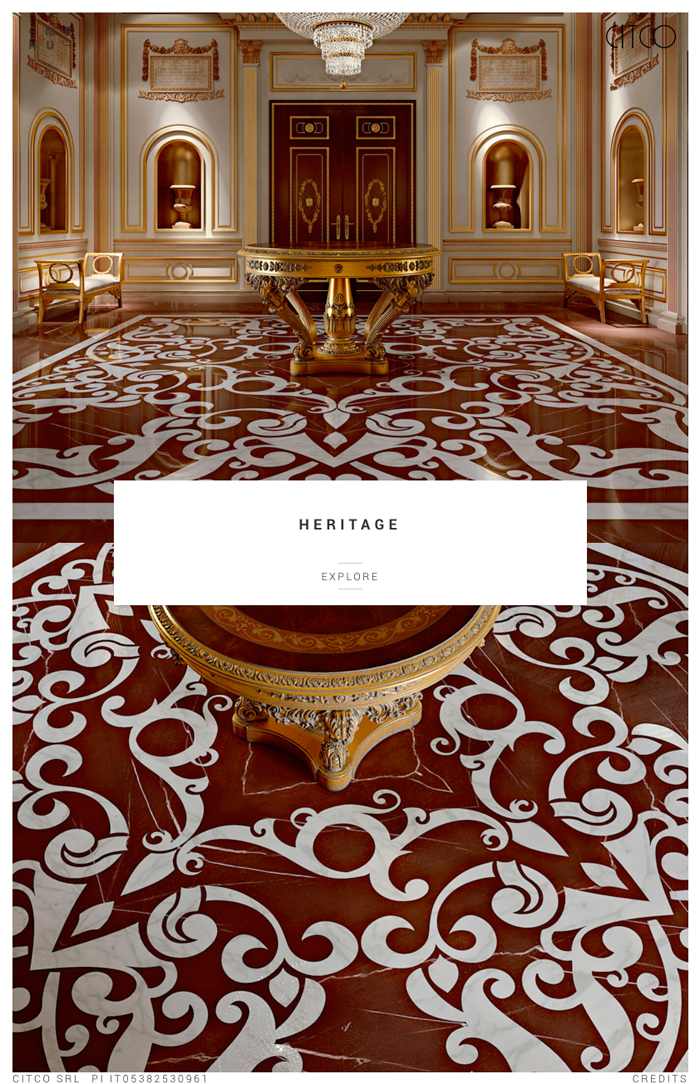
Image via Citco
Italian luxury design brand Citco has paved the way with innovation, creating new means of bringing a classic luxury material–marble–into the homes of consumers. When we think of marble we traditionally think of countertops and floors, but Citco’s designers use the prized rock to craft furniture, accessories, ornate wall coverings and more.[3]
Marble itself is nothing new, but Citco uses it in an innovative way to stay fresh and interesting in the minds of luxury consumers. Remember, it’s not always about reinventing the wheel, but finding forward-thinking ways to use the proverbial wheel to engage with luxury customers.
Related: Design Is NOT Branding, 10 Things Every Business Owner and Entrepreneur Should Know
Identifying your brand values is one thing, but putting them to work in your business day in and day out is another! It comes down to having a well-structured brand strategy. Get professional direction building your brand strategy so that it underpins your business goals and makes a lasting impression in the minds of your customers. Get in touch here.
2. Luxury Brand Personalization
Over the past decade, we’ve seen a sweeping shift from bricks-and-mortar storefronts to online shopping, with traditional powerhouses like Sears and Macy’s closing physical locations in record numbers to focus on online efforts. Luxury brands, however, have lagged behind, maintaining a focus on expansion through physical storefronts.
The result is a deficit in the digital environment for many luxury brands.
The modern luxury consumer has forged ahead, though, and this clientele now demands that the online shopping experience of their favourite high-end brands is very personalized like that of e-commerce giants like Amazon and ASOS.
The contemporary luxury consumer wants to shop where and when she or he pleases. According to Deloitte’s Global Powers Of Luxury Goods Study, 39% of luxury consumers want additional shopping channels (like home delivery) at their disposal, while 45% crave greater personalization in the products and services they’re offered. [4]
Related: Luxury Branding: How to Establish or Re-Position Your High-End Brand
Online luxury fashion house Net-A-Porter has done an exceptional job meeting the personalization demands of luxury consumers. The brand blazed a trail by taking high-fashion looks straight off the pages of Vogue and Harper’s Bazaar and making them accessible to customers with a single click.
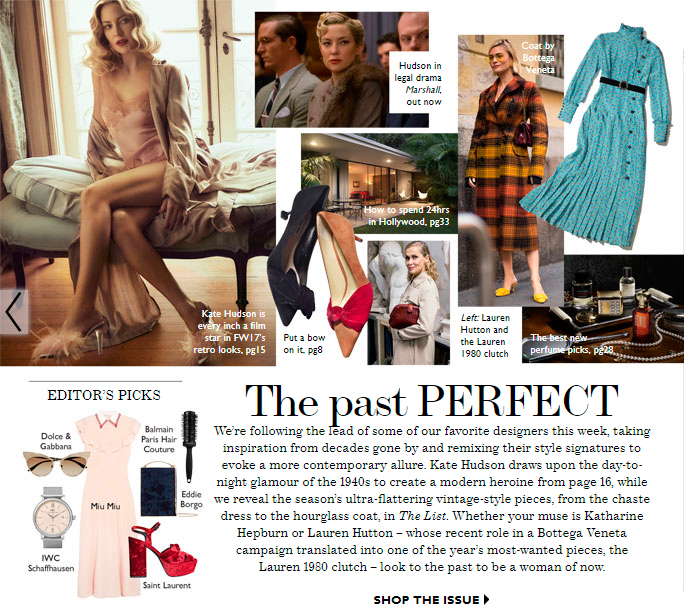
Image via Net-A-Porter
Despite the massive success, Net-A-Porter didn’t stop with simply aggregating and recommending products; it now partners with esteemed luxury brands like Burberry to create custom collections exclusively for the Net-A-Porter platform.[5]
By following Net-A-Porter’s example and seeking new ways to make the shopping experience a more personalized one, luxury brands will build trust and loyalty in the hearts of followers, which in turn drives revenue growth.
3. Social Responsibility Among Luxury Brands
The modern customer prefers to spend his or her money with brands that demonstrate social responsibility, and Millennials are leading the charge. Millennials are twice as likely to buy from brands that demonstrate strong management of environmental and social issues. Luxury brands aren’t immune to the trend.[6]
88% of UK and US Millennials and Generations Xers believe brands need to do more good.
The majority spend more on experiences rather than accumulating more ‘stuff’ and they are also driven by the ‘clean-label’ trend — the need to verify what’s in everything and where it came from.[7]
Many luxury goods depend on natural resources that, unfortunately, are in limited supply (think gold, precious gems and rare minerals). A socially responsible luxury brand must ask the tough questions and carefully consider how its business model impacts things like energy, climate, natural resources and supply chain sustainability.
Related: Purposeful Brands: Why Customers Are Prepared to Pay More
For centuries, diamonds have been synonymous with luxury. In recent years, however, the luxury jewellery staple has become problematic with the rise in awareness about conflict diamonds, or diamonds mined to support the regime of warlords and oppressive leaders.
One of the most well-known diamond purveyors, Tiffany & Co., has stepped up to meet the issue head-on. The brand helped to found the Initiative for Responsible Mining Assurance and has adopted a stringent zero-tolerance policy for stones mined in countries known for human rights violations.[7]
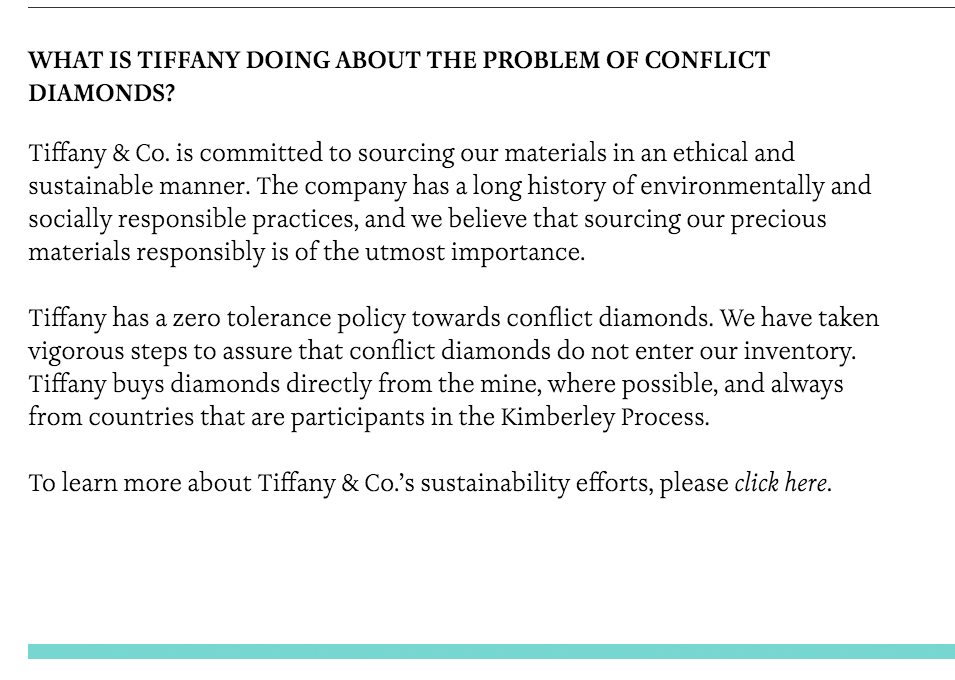
Image via Tiffany
The brand communicates its commitment to “traceability and transparency” through its brand collateral, like this video on “The Journey of a Tiffany Diamond.”
To become a lasting luxury brand, it’s important not only to adopt a strong and very authentic social responsibility brand strategy but to communicate it clearly to your audience across multiple channels.
Related: Brand CSR, The Business Case for Successful Branding and Social Good
Need to define the core brand values that connect you with your ideal audience? Our Personality Profile Performer™ is a highly effective programme that will take you step-by-step through the process of reevaluating and building your brand so you can increase your sales. Check it out here.

Build your standout brand here with Lorraine Carter
5. Luxury Brand Timelessness
To cement your place as a lasting luxury brand you must, well, last! One of the intrinsic components of luxury is the feeling of timelessness; a true luxury product never goes out of style.
For luxury brands, this means staying true to their long-established values while evolving and staying relevant to the modern customer.
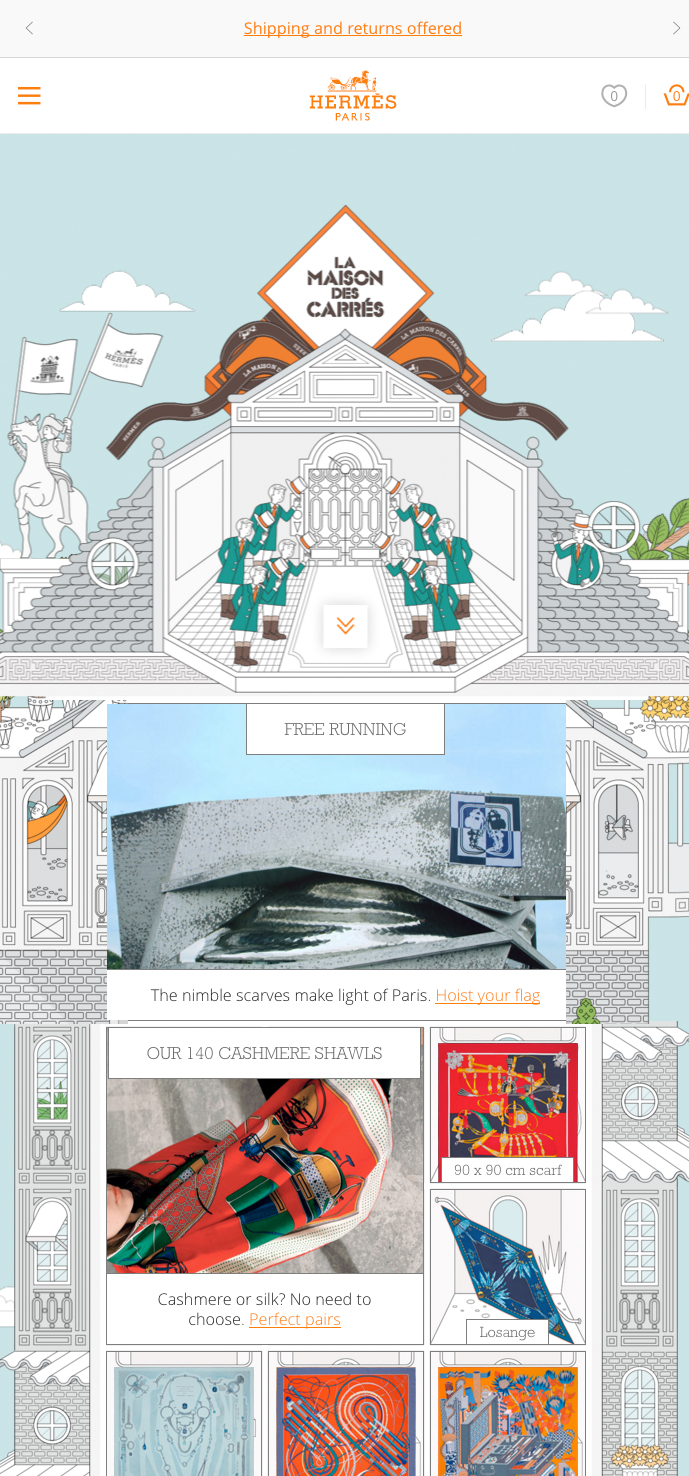
Image via Hermès
It’s difficult to discuss luxury without mentioning Hermès, and one reason for that is the brand’s mastery of timelessness. Case in point: Hermès silk scarves. They’ve been gracing the necks of luxury consumers since 1837, and their designs have remained largely unchanged since then.
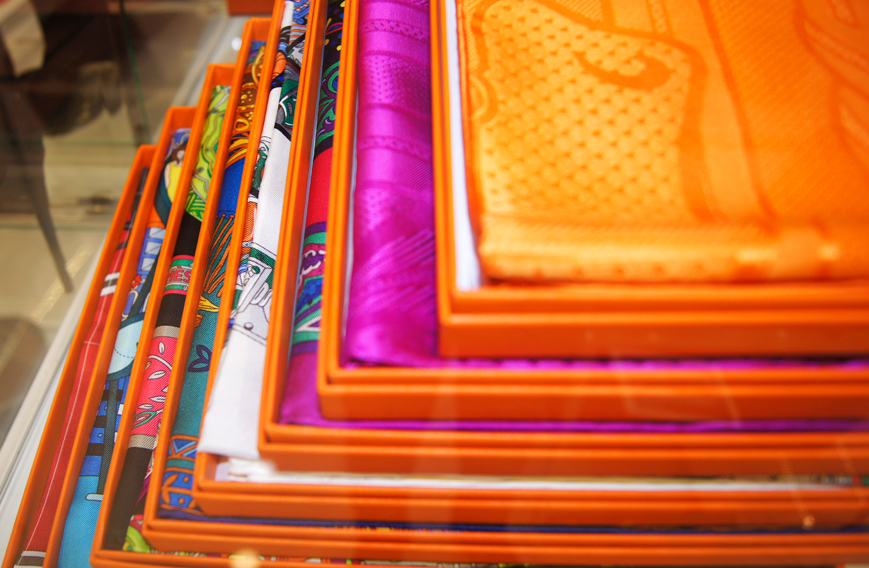
Image via Hermès
The brand, however, has adapted, embracing new marketing mediums like fashion blogger collaborations, digital video and Instagram influencers who sport the classic silk accessory.
Hermès strikes the perfect balance between relevance and timelessness and sets an example all lasting luxury brands should strive for.
6. Luxury Brand Inclusion
Traditionally, luxury branding has been focused on exclusivity. After all, the very nature of luxury is based on the understanding that it’s not something to be had by the masses. In recent years, however, the concept of exclusivity has taken on a negative connotation. For a lasting luxury brand, exclusivity cannot equal exclusion.
In our modern social and political landscape, it’s more important than ever for luxury companies to use their brand story to promote a brand culture of inclusion. This may cover race, nationality, sexual orientation, gender identity and more.
Related: How to Develop Your Brand Tone of Voice to Increase Sales
Luxury staple Gucci recently took the lead in the campaign for inclusiveness by partnering with Parks, an Italian organization dedicated to helping companies develop practices that support and value diversity.[8] Gucci took the group’s counsel to heart, releasing a 2017 pre-fall advertising campaign exclusively featuring models of colour.
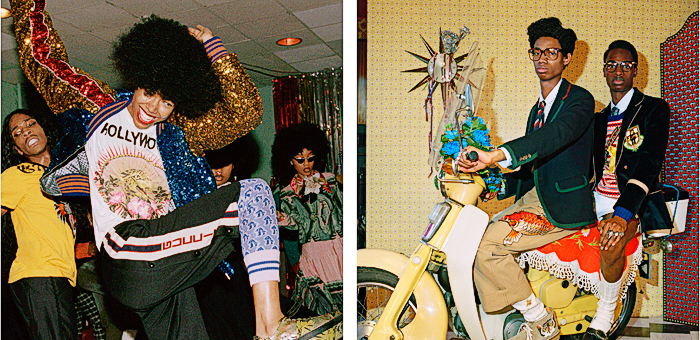
Image via Gucci
A modern luxury brand must take similar initiatives to incorporate inclusion into its brand values and live it through meaningful action.
7. Experiential Versus Physical Luxury Brand Interactions
As we touched on earlier, luxury consumers are moving away from the traditional bricks-and-mortar store experience in favour of an online, mobile one. Without as much opportunity for a face-to-face interaction with the customer, luxury brands must place a greater focus on creating a more positively memorable customer experience rather than simply a transaction with the consumer when the sale takes place.
According to Deloitte’s study, today’s luxury consumer cares less about using a luxury product or good to convey “what I have” and more to convey “who I am.” As such, a greater value is placed on the experience of using the product or service–how it makes the customer feel–versus simply the status of owning the product.
For a case study in experiential interactions, look no further than Silversea Cruises. This luxury cruise line is taking the cruise experience one step further than the ship itself, now offering extravagant pre- and post-cruise itineraries featuring once-in-a-lifetime experiences like spotting gorillas in the Rwandan jungle or watching penguin chicks hatch at the South Pole.[9]
From the pouring of tea into a delicate teacup to the drops of mist spraying from a waterfall, the scenes captured in the above video leave no question that the ‘Couture Collection’ is all about an unparalleled experience.
To become a lasting luxury brand, focus not just on creating a luxe product or service, but on designing an unforgettable customer experience around the customer journey, sales transaction and beyond. Nurture your customers every step of the way, including long after the sales process is completed.
It’s clear that the luxury market is at a crossroads, and luxury brands must either adapt or be left behind. Luxury brands that wish to overcome the flat-growth trend of the last several years must look to the customer to guide their brand strategy and be mindful of innovation, personalization, social responsibility, timelessness, inclusion and experience — all components the modern luxury customer demands.
Building a brand strategy can be challenging, but it’s one of the most important parts of your brand building process. Get expert guidance on creating and executing a clear brand strategy that aligns with your business goals. Get in touch here and let’s talk more about your unique goals.
Questions to Consider in Relation to Your Luxury Brand Strategy
- In what way is your luxury brand innovative? Are you clearly conveying that to your ideal customer?
- How can you create a more personalized luxury brand experience for your customers?
- Is your company socially responsible? Is there room for improvement with your luxury brand in this area?
- What are the most timeless elements of your luxury brand? How can you infuse those elements into modern branding channels?
- Is your luxury brand inclusive? How do you convey inclusion in your luxury brand collateral and communications?
- What are some ideas for focusing more on the experience with your luxury brand rather than merely the transaction?
- http://www.bain.com/publications/articles/luxury-goods-worldwide-market-study-fall-winter-2016.aspx
- https://www.forbes.com/sites/pamdanziger/2017/08/08/luxury-brands-innovation-is-no-luxury-but-a-necessity/#368a3b38303a
- http://robbreport.com/shelter/home-design/revered-italian-marble-company-opens-its-first-us-showroom-233379/
- https://www2.deloitte.com/content/dam/Deloitte/global/Documents/consumer-industrial-products/gx-cip-global-powers-luxury-2017.pdf
- http://www.vogue.co.uk/gallery/burberry-capsule-collection-net-a-porter-launch-images
- https://hbr.org/2016/02/luxury-brands-can-no-longer-ignore-sustainability
- https://hbr.org/2016/02/luxury-brands-can-no-longer-ignore-sustainability
- http://www.telegraph.co.uk/luxury/jewellery/tiffany–co-leading-the-way-in-ethically-produced-jewellery/
- http://wwd.com/business-news/human-resources/gucci-promotes-diversity-inclusion-parks-liberi-e-uguali-10810309/
- http://robbreport.com/travel/destinations/silversea-cruise-line-launch-collection-land-itineraries-2018-2752738/
Top 10 Branding Articles in 2015
/0 Comments/in Brand Collaboration, Brand Culture, Brand Personality, Brand Premiumisation, Brand Profiling & Positioning, Brand Relaunch, Brand Revitalisation, Brand Story, Brand Strategy, Brand Values, Branding, Branding Trends, Co-Branding, Colour Psychology, Global Branding, Innovation, Luxury Branding, Millennial Branding, Packaging, Packaging Design, Premiumization, Rebrand, Rebranding, Return On Investment, Revamped Design, Revitalized Design, Storytelling, YouTube /by Lorraine CarterAre you curious which Persona Branding and Design articles have been the most popular over the past year?
We’re always interested to see which of our posts resonate most with you, our reader. Even though we do lots of research and planning, there are no guarantees which topics will trigger the most interest.
Here you’ll find an insider’s peek into our top ten most popular branding articles of 2015, some of which you might have missed.
I’m sure you’ll find at least one that will be very useful to your business in the year ahead.
Wishing you growing success in 2016!

1. Rebranding Strategy: Why Your Rebrand Must Embrace Storytelling
The differences between a tired, old, has-been of a brand and a fresh, lithe and provocative one can be boiled down to a singular concept: storytelling. The art of telling a story, and telling it well, is integral to grabbing every potential customer’s attention, and a key part of your brand strategy.
The secret to success in the elegant art of storytelling lies in understanding its fundamental components. Though by no means comprehensive, what follows is a breakdown of some major elements that any good story should include. These are in fact some of the key ingredients we incorporate in our Story Selling System™ used when developing our clients’ brand stories:
The Top 5 Components of a Great Brand Story are as follows…

2. Creating New Brands: Top 10 Tips for Brand Success
Launching a new brand is both exciting and challenging. The excitement comes in the promise of something fresh and new that could be wildly successful, be it for your well established, emerging or new start-up company — and the challenge comes in getting it right the first time.
Evaluating, articulating, developing and documenting your new brand’s position and purpose is crucial to building a strong successful brand.
It provides the roadmap and rationale to get you out of the starting blocks and heading in the right direction towards your ultimate success. And similar to your business plan, it’s also a key foundation to any successful business, be it product or service.
The question here is, do you know the key ingredients required for building a new brand?
To help you move in the right direction with your branding here are some of the elements we typically include in our branding process every time we’re working with a client to help them build their brand, whether it’s revitalizing an existing brand or launching a totally new brand to market.

3. What Customers Want: Top 16 Branding Trends in 2016
More than a half century ago, the customer-centric branding pioneer Walter Landor said, “Products are made in the factory, but brands are created in the mind.” [1] In 2016, the path to that consumer experience is a two-way street, and guess who’s in the driver’s seat? Brands with strong personality are the winners, because consumers equate experiences with brands.
Branding keywords for 2016 include: personalized, authentic, humanized, interactive, engaging, and mobile.

Image via www.edelman.com
4. Brand Profiling: Top 6 Components to Creating a Strong Brand Personality
Your brand is much more than merely a product or service, or a logo. Brands are an experience—the relationship between your business and your customers—and to create an exceptional customer experience, your brand must have an irresistible personality.
To quote Martyn Newman PhD “In the information age and globalised economy where values and meaning matter more in the market place, the value of emotional capital increases. This creates brand value and goodwill and results in repeat sales through customer loyalty, lifetime relationships and referrals. In other words, the brand is more than a name or a logo; it creates trust and recognition and is a promise and an emotional contract with each customer.”
Brand profiling is the systematic process of creating, developing and implementing your brand character and personality through shaping its brand promise, values, the do’s and don’ts of its behaviours, story, emotional benefits, its culture and what it stands for and so forth.
It’s this humanized entity that gets your brand message out into the market, cuts through the noise and gets the attention of your primary customers in a way that matters to them.
When creating and developing the profiles for our clients’ brands we use our bespoke Personality Profile Performer™, a systematic approach which underpins the commercial, rational, and holistic aspects of successful brand profile building.
The following six key elements are representative of some of the core ingredients included within this branding process, used to create and deploy a compelling personality for your brand.

Image via © www.eqsummit.com
5. Co-Branding: 13 Tips for Growing Your Brand Through Strategic Partnerships
Co-branding is defined as a partnership between brands. It typically works best when Brand A partners with Brand B, each with a different set of customers and brand associations of their own.
As in the expression, “the whole is bigger than the parts,” co-branding can add value when synergy exists between the brands; it creates an emotional energy, starts conversations and creates buzz around both partners and can delivery significantly increased financial returns for all involved when done right.
In addition to brand revitalization, co-branding objectives may include getting more bang for your buck, growing market share, building audience reach and altering perceived positioning. Co-branding is primarily used an alliance of two brand partners, although there’s no rule against bringing three or more to the party.
Checkout here:
• The Top 7 Benefits of Co-Branding
• 5 Co-Branding Risk Management Guidelines
• The Top 6 Tips for Co-Branding Success
with case studies and examples of who’s done it really well.

Infographic via www.missvinc.om
6. Colour Psychology: Cracking the Colour Code for Profitable Branding
Colour increases brand recognition by 80%. 93% of shoppers consider visual appearance over all other factors while shopping. It adds huge power to communications, opinions, recall and emotive influence. In fact when used correctly, colour is a pivotal tool to substantially influence purchasing decisions, service or product.
Since colour choices impact every aspect of a commercial enterprise, brand owners should aggressively re-evaluate that choice throughout their brand strategy.
The question is, has your brand’s colour palette been selected with the right intent and applied to best possible effect throughout all your brand communications and touch points to ensure your brand grow and increased profitability?
Find out more about why colour matters and how you can use it more effectively within your business.

Infographic via Blueberry Labs
7. Packaging Design: How to Make it into an Irresistible Customer Brand Magnet
The growing proliferation of multiple different brands in the market place has made customers spoilt for choice, but often at the expense of easy decision-making.
When presented with an assortment of packaging options in which nothing decisively stands out, with a compellingly clear message that speaks to a customer succinctly, analysis paralysis sets in. It’s when faced with this situation that a confused shopper will typically default to making decisions based on price alone.
The question here is, where does your brand sit in the mix?
Leading brands cut through the visual and cognitive noise created by an oversaturated market full of aggressive competitors and hook their ideal customers by meeting their needs both emotionally and rationally.

Image via © www.marmite.co.uk
8. Luxury Branding: How to Establish or Re-Position Your High-End Brand
The combined value of the various luxury goods markets in 2014 was an estimated 865 billion euros, with luxury cars, personal luxury goods and luxury hospitality taking the top three places, with values of 351 billion, 223 billion and 150 billion respectively.
You might think those statistics make luxury branding a very interesting sector, however if you want to reposition or establish your brand targeted at a high-end customer then there are six keys factors you need to consider within your brand strategy.
Firstly there are four main characteristics by which the luxury customer defines a luxury brand. However the way in which someone perceives luxury will depend on factors ranging from their socio-economic status to their geographical location.

Infographic via Raconteur.net
9. Millennial Branding: 6 Ways Your Brand Can Appeal to Millennial Customers
Millennials, the newest generation of influential consumers (also known as Generation Y or Gen Y), spend more than $600 billion dollars annually with spending power expected to reach $1.4 trillion by 2020, (or 30% of US sales) according to Accenture 2013 research.
While these statistics sounds like ‘gold bullion’ for many brands, in our experience often smaller companies and organisations struggle to develop their brand strategy in a way that relates relevantly to this fast changing group of buyers.
Millennial consumers are a very fluid constantly moving target with multiple devices overflowing with content clamouring for their attention 24/7. However once you really understand this discerning consumer properly and tailor your brand to really meet their needs, you can, like many others tap into this incredibly lucrative market.

10. Video Brand Strategy: Top 11 Tips for How and Why You Need to Use Video
The average consumer spends 88% more time on content with video and video is shared 1200% more times than links and text combined. A landing page with video gets 800% more conversion than the same page without video.
If you ever thought using video to promote your brand was too difficult or beyond your reach these statistics might make you think again.
Find out exactly how you can use video to grow your brand here.
You can even find out how one small start up brand used video to achieve worldwide distribution and now has more online viewers than its competing massive global brands combined!

Image via Google / YouTube
Did your favourite post feature in one these top 10 branding articles of 2015? If there was an alternative that was your first preference, drop us a line and let us know.
Meantime I’d love to keep you up to date with what’s happening in the world of branding and make this blog really useful to you. If there’s anything branding related you would like to read about in this blog or if you have any questions or comments, suggestions for a blog post, feedback or even just to say Hi, just send me a short note, I’m here to help!
or give me a call at Tel: +353 1 8322724
Wishing you increasing success in the year ahead!
Luxury Branding: How to Establish or Re-Position Your High-End Brand
/0 Comments/in Brand Ambassador, Brand Audit, Brand Auditing, Brand Audits, Brand Champions, Brand Collaboration, Brand Experience, Brand Health Check, Brand Identity Design, Brand Personality, Brand Premiumisation, Brand Profiling & Positioning, Brand Promise, Brand Strategy, Branding, Co-Branding, Luxury Branding, Packaging, Packaging Design, Premiumization /by Lorraine CarterThe combined value of the various luxury goods markets in 2014 was an estimated 865 billion euros, with luxury cars, personal luxury goods and luxury hospitality taking the top three places, with values of 351 billion, 223 billion and 150 billion respectively. [1]
In order to understand the branding strategies developed and utilized by the top luxury brands, those who have maintained their reputation for over several decades, as well as those that have successfully re-positioned themselves as high-end brands, we must first look at the very definition of luxury.
There are four main characteristics by which the luxury customer defines a luxury brand:
- Quality
- Craftsmanship
- Exclusivity
- Elegance
However, the way in which someone perceives luxury will depend on factors ranging from their socio-economic status to their geographical location. According to latest Albatross Global Solutions and Numberly study, “The Journey of a Luxury Consumer”, people from different parts of the world prioritize the order of importance of these key factors differently when defining luxury goods. For example, an overwhelming majority of luxury consumers worldwide value quality above all else, however, UK luxury consumers place more importance on craftsmanship, while elegance plays a more vital role when it comes the global luxury market.
Since customer preferences and definitions can vary from one jurisdiction to another, luxury brands need to tailor their brand communications strategy for each of the relevant market segments they are targeting, while remaining true to their core brand values, brand DNA and brand story. It can be challenging but with the right brand strategy it can be hugely rewarding, as evidenced by Louis Vuitton and their distinctly different approach to marketing their luxury brand in Japan.
The brand collaborated with Japanese artist Takashi Murakami in the early 2000’s to create a more colourful version of their classic monogram, and even reduced prices slightly during the economic crisis, to retain its position on the Japanese luxury market. However, it performed best when focusing on the quality and craftsmanship aspects of luxury brand on the Japanese market, as opposed to the allure of exclusivity and elegance — that had a greater impact with their customers in Western countries.
Luxury is About Exclusivity
In order to thrive, a luxury brand needs to secure its own unique corner of the market. Premiumisation strategies or high price points are designed to attract a particular kind of customer while alienating others – the high quality, and the unique experience that a luxury brand provides will not be right for everyone, nor should it be. To quote the head of Lexus Europe, Alain Uyttenhoven: “Our cars won’t please everyone.”
The brand strategy developed and deployed in different jurisdictions often varies because the definition of luxury changes amongst consumers as we move around the world and up the socio-economic ladder. Also, some of the top luxury brands strategically choose to stay out of the most obvious limelight. Very subtle marketing and the fact that the general public isn’t necessarily aware of their existence creates a unique aura of mystique and exclusivity. It also alludes to the fact that high-quality craftsmanship and aesthetics are amongst luxury brands’ highest priorities, values which are not compromised by things such as price sensitivities.
The brands at the very top of the luxury spectrum are not necessarily bound by the same constrictions of the more mainstream ‘accessible’ luxury or premium sector. Indeed, more exceptionally wealthy clientele might perceive price tags or ostentatious displays of affluence as lacking in taste in certain markets. In fact, there is a wise old saying in the luxury yacht industry: “If you have to ask about the price, you probably can’t afford it.”

Infographic via Raconteur.net
The French purveyor of personalized luggage, Goyard, is a fine example of a luxury fashion brand that has retained its high-end status for over a century, continually prospering without engaging in many of the strategies that are considered to be the cornerstones of effective mainstream marketing.
The brand favours direct sales and word of mouth marketing over media hype, large-scale advertising and online sales, even though Goyard has thousands of followers on several social media platforms, including the luxury brand’s newly launched YouTube channel.
This extreme level of exclusivity amongst long established luxury brands, e.g. specialising in a single product category to the point of elevating a brand to the level of art or supreme craftsmanship, can be used as one element of a brand strategy to create distinction and separate it from the rest of the market, but it can also be a more challenging route for newer entrants to the luxury market.
The luxury landscape is changing, and a brand can quickly become irrelevant if it lacks online exposure. Millennials are close to outspending Baby Boomers, according to a Berglass + Associates and Women’s Wear Daily study that explored the retail industry, which means that a brand has to account for the values that drive Millennials when developing their brand strategy.
For Millennials the bigger purpose of a brand, its big why, has a significant impact on their purchasing decisions which means that CSR and so forth has a bigger role to play in brand strategy than every before — for this growing audience.
The smartphone is an essential component of the Millennial lifestyle because it allows easy access to multiple online platforms and immediate connectivity – 85% of Millennials in the 18-25 age bracket and 86% of those in the 25-34 age bracket own a smartphone[2], while 88% of Millennials use Facebook as their primary news source.[3] For more traditional brands this means embracing new fully integrated brand strategies that wouldn’t have seemed relevant eight to ten years ago.
Even luxury brands that are primarily focused on in-store purchases, e.g. Goyard, are investing in social media and reaching out to affluent Millennials. The way that younger generations perceive luxury is markedly different from the way Baby Boomers perceive it, and luxury brands have a challenging task ahead of them – educating Millennials on luxury goods and adapting their brand strategy to fit the Millennial lifestyle.
Develop Trademark Brand Symbols and Assets Beyond Just Your Brand Logo
Rolls-Royce Phantom Drophead Coupé has been virtually unchanged for years, and the silhouette itself is just as recognizable as the logo, brand name and the Spirit of Ecstasy mascot attached to the bonnet.
It’s the Rolls-Royce uncompromising commitment to quality craftsmanship and attention to detail that has the brand where it is today. When we work with clients to develop a distinct brand identity that reflects their core brand values, personality, story and communicates their brand message it requires a similar level of focus from everyone working on the project coupled with a deep understanding of the brand’s primary target audience in order to achieve successful results.
Burberry’s trademark black, tan and red check pattern and Channel No. 5 perfume’s simple, yet elegant bottle design are both instantly recognised by the average consumer. These are distinct, different and memorable brand assets that are as important as the brand names themselves.
Founded 150 years ago Burberry is a particularly interesting case study because not long ago it was struggling to maintain a consistent brand identity leading to the brand falling off its luxury positioning, despite its admirable provenance. Inconsistencies in product variants, pricing and communication strategies all combined to undermine the brand. In fact this brand, now worn by Emma Watson and Kate Moss to mention a few high profile names, was once at risk of being considered frumpy before its very successful luxury revitalization strategy was implemented so successfully.
It wasn’t until Angela Ahrendts took over as CEO that a long-overdue brand repositioning and brand relaunch was set in motion resulting in the iconic and much sought-after luxury brand we see today. The company was restructured and the sourcing of materials and production was centralised in the UK. Burberry stores were modernized and equipped with iPads, digital displays and audio equipment that enabled the brand to showcase its quality craftsmanship through video material, and to provide a more engaging customer experience.
However, the true stroke of genius was the decision to focus on a younger demographic, and utilize social media as a powerful promotional tool. To successfully target the affluent Millennial consumer, Burberry had to diversify its product line and make significant stylistic changes, while at the same time retaining the timeless aesthetic that the brand was once known for.
The results of the brand relaunch were astonishing – Burberry doubled their revenue and operating income within five years, and successfully repositioned their brand as a luxury brand. Their famous Burberry check is once again associated with premium quality British craftsmanship.
Provide a Memorable Brand Experience for Your Customers
With a luxury product, the brand packaging, presentation and shopping experience are just as important as the quality and exclusivity of the product itself. Luxury customers are far from average shoppers, they are wealthy and powerful people with refined tastes. A luxury brand has to engage these customers on multiple levels – spark curiosity, engage all the senses, stimulate the mind, and make an emotional connection.
The Gentleman Floris, a new line of luxury men’s grooming products launched by the Floris London, a nearly 300-year-old British family perfumers brand since 1730, uses understated heraldic symbolism on the embossed navy blue packaging to reference its noble origins and royal patronage coupled with its renowned to quality, craftsmanship and rich heritage. The brand story is used eloquently to draw its audience in and sell its brand proposition.
We have created many different packaging design solutions for clients over the years, both luxury and FMCG, and when you consider that on average you have less than 9 seconds to engage your customer through the impact your packaging design has on them, it is critical that your customer gets an immediate sense of your brand story, promise and values if you want to close the sale.

Image via www.florislondon.com
In luxury branding everything from the customer journey to the brand experience and customer service, not to mention the accessories, has to be carefully considered to ensure that it’s elevated to an exceptional level.
The brand experience has to be much more personal, which means that staff, your brand ambassadors, must be chosen to fit with your brand values and culture. They need to be fully inducted and trained in all the details of how your brand is lived and experienced, both internally and externally, and how that unique brand experienced is transferred and cultivated with each the individual customer.
Sometimes this training may also require the front line staff to make important judgement calls in the heat of the moment, in order to accommodate the customer’s specific needs. At the Ritz-Carlton Hotel, each employee is empowered and trained to anticipate and fulfil their guests needs with an exemplary level of service.[4]

Image via www.Ritz-Carlton.com
The Ritz-Carlton is another good example of a luxury brand that successfully maintain its positioning for decades and in fact case studies have been built around its success. The Ritz-Carlton Leadership Centre is now the place where executives from other companies worldwide in many different sectors come to learn The Ritz-Carlton principles of service.
The Ritz-Carlton success is due to a number key factors such as they have:
- A formulated a set of standardized hiring criteria
- Empowered their front line staff and instituted a standardized brand language
- A consistent high-end luxury brand experience regardless of location
- Take note of user feedback, perform regular brand audit health checks
- Constantly evolved to adapt with the times while staying true to their core brand values
The Ritz-Carlton has created an admirable balance between maintaining a consistent brand image and evolving to meet the needs of a new generation of patrons who prefer more authentic interactions with the staff. It’s their uncompromising commitment to excellence which has made them the only brand to win the much sought after US Presidential Baldrige Performance Excellence Award twice, firmly establishing Ritz-Carlton’s positioning as a luxury brand and setting the highest standards for customer service throughout the luxury hotel market.
Create an Aura of Exclusivity by Limiting Supply
Special limited edition items often become cherished collector’s pieces and dramatically increase in value over the years. In fact, the lack of product availability doesn’t negatively affect a luxury brand they way it might other mainstream brands. Its limited availability to the select few makes it even more appealing to its target customers.
Long waiting lists have never deterred Hermès fans, who often wait several months for the privilege of purchasing the brand’s signature Birkin bag. [5] Some of the most popular luxury car brands are the ones with both the highest prices and longest waiting lists. Only the most persistent and loyal customers gain access to these limited items, which enables you as a brand owner or manager to create an elite subgroup within your customer base.
The Rolls Royce SG50 Ghost Series II is a prime example of a brand offering a limited edition product to a particular segment of their target demographic, another example of the exclusivity strategy at work, and establish an emotional connection with its customers. In this particular example, Rolls Royce honours the fact that 2015 marks 50 years of Singapore’s independence, helping it increase individualised customer brand relevance and secure an increased market share in one of Asia’s most developed economies, second only to Hong Kong in terms of financial freedom.

Image via www.luxuriousmagazine.com
The Apple Hermès brand collaboration helped connect the luxury fashion brand connect to a well-developed demographic of tech-savvy affluent Millennials while at the same time opening the horizons of the wealthy Apple users to the allure of a luxurious brand such as Hermès.

Image via www.apple.com
High-end craftsmanship and a sense of exclusivity have already been associated with both brands, but the halo effect of this collaborative project, the super-luxurious Apple watch, has proved to be quite beneficial in terms of exposing previously unexplored segments of the market to each brand.
Luxury watch aficionados and loyal Hermès customers who are delighted with this new offering will be tempted to explore some of the other Apple devices. On the other hand, the more affluent Apple consumer may easily eschew their previous luxury favourite and make Hermès their alternative preferred choice instead.
Be Proud of Your Heritage, but Offer Customization to Build an Emotional Connection
Giving consumers some decision-making power over the production process, even if their contributions are limited to the choice of colour or engraving, accomplishes several things:
- It turns each product into a personalised more unique item that is to be cherished
- It creates a more personal connection between the customer and the brand
- It enhances the overall customer experience
Goyard doesn’t offer a diverse product range, but what it does offer is the ability choose from a wide range of colours and styles. A luxury customer can leave the Goyard store safe in the knowledge that the product they have purchased is truly unique, and tailored to their personal tastes.

Image via www.Goyard.com
Luxury brands can also use their geographical location to their advantage. A luxury brand is often associated with its country and region of origin – sparkling wines from the Champagne region have become a key component of many major celebrations, BMW and Mercedes are touted as the epitome of German engineering precision and so on. The brand thus takes on the qualities associated with the local culture. We can use Burberry as a good example once again – its British heritage has been a key component in successfully repositioning the brand as a high-end brand.[6]
Create an Epic Brand Story that Mesmerizes Your Customers
A good brand story is instrumental in capturing the imagination of customers, but a luxury brand needs to go beyond mere storytelling and develop a veritable fairy-tale that fully immerses a customer, to the point where he or she wants to become a part of your luxurious world. The brand experience and how that is created lived and experienced is the penultimate test.

The legend of Coco Chanel and the immense respect consumers still have for the Chanel brand matriarch is a prime example of how effective legends can be in promoting a luxury brand. Her humble beginnings, timeless style and daring persona are woven into a narrative that all ambitious, independent, fashionable and adventurous women around the world find inspiring.
On the other hand, we have brands with a proud and storied history, such as White’s Gentlemen’s Club in London, which has no intention of expanding or opening its doors to anyone but the most select clientele.

Image via www.Goyard.com
Much like Goyard, White’s has no need for heavily resourced marketing campaigns, as it relies on its few elite “members” for word of mouth marketing. With patrons like Prince Charles and several British Prime Ministers gracing the bar and gaming rooms with their presence, being a member of White’s Gentlemen’s Club is considered a privilege. Even David Cameron’s vocal critique of men-only clubs and the fact that the British Prime Minister resigned from White’s did little to tarnish the reputation built on several centuries of myth and legend.
Key Takeaways to Consider
In conclusion, here are some key points to keep front of mind when re-evaluating your luxury branding or premiumization brand strategy:
- Ultra premium luxury brands often use understated branding strategies coupled with word of mouth, but offer unmatched top end quality and exclusivity
- Brands that have successfully repositioned themselves have invested in brand audit health checks and embraced the affluent Millennial demographic and use social media to spread brand awareness
- Luxury brands that have successfully maintained their positioning for decades have used their provenance and leveraged near mythical brand stories to maintain brand distinction, but continued researching the market and changing trends regularly, and encouraged customer feedback to maintain relevance
- Providing an exceptional customer experience in-store, through empowering frontline staff and developing a consistent brand language, is very important, as a majority of luxury consumers make their purchases in person
- Involving customers in the production process enables a luxury brand to personalise its offering with a diversified range of unique variations, even if it doesn’t have an extensive reach across multiple categories
- Collaborating with a brand that has a significantly different customer base and brand associations can produce a halo effect that is highly beneficial for both brands
You may also like:
• Co-Branding: 13 Tips for Growing Your Brand Through Strategic Partnerships
• Brand Audit: Tips for Determining Your Brand’s Health – Can it be Improved?
• Rebranding Strategy: Why Your Rebrand Must Embrace Storytelling
• Rebranding Strategy: Using Premium Repositioning To Increase Profitability
• Colour in Brand Strategy: Colour Psychology and How it Influences Branding
• Video Brand Strategy: Top 11 Tips for How and Why You Need to Use Video
• Creating New Brands: Top 10 Tips for Brand Success
• Brand Profiling: Top 6 Components to Creating a Strong Brand Personality
• Millennial Branding: 6 Ways Your Brand Can Appeal to Millennial Customers
So, what do you think?
• Have you performed a brand audit to identify the holes in your luxury branding strategy?
• Is your brand utilising social media to its fullest potential and reaching out to affluent Millennials?
• Are you using appropriate brand language?
• Have you created a consistent brand image?
• Have you considered how you can make your brand more profitable by changing your brand strategy with a premiumization approach to reposition your brand, create an aura of exclusivity and attract luxury consumers?
• Do you have an exceptionally engaging brand story that elevates the brand to legendary status and could be leveraged to better effect with a rebranding?
[1] Statista.com, Value of various global luxury markets in 2014, by market type (in billion euros)
[2] Nielsen, Mobile Millennials: Over 85% of Generation Y Owns Smartphones, September 2014
[3] Americanpressinstitute.org, How Millennials Use and Control Social Media, March 2015
[4] Forbes.com, Micah Solomon, Your Customer Service Is Your Branding: The Ritz-Carlton Case Study, September 2015
[5] Uché Okonkwo, Luxury Fashion Branding: Trends, Tactics, Techniques
[6] The Australian, “Paul Smith, Burberry and Mulberry Revive ‘Made in Britain’”, September 2014
About
Persona Branding & Design Consultants
Contact: Lorraine Carter
T: +353 1 832 2724
Carra House
Howth, Co. Dublin, Ireland
Copyright © 2007-2022 All rights reserved.
Persona Design Consultants Ltd.
Registered in Ireland: No. 201997
Member of


